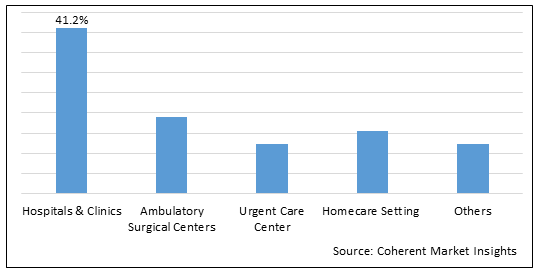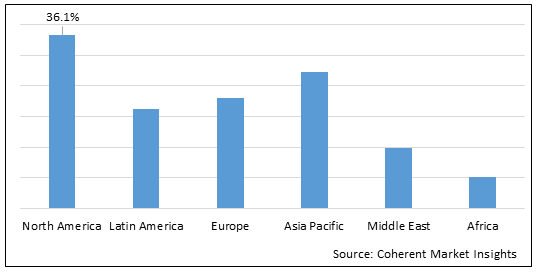Personal mobility devices play a major role in advanced healthcare, as it aid in mobility of the disabled people and enhance the independent living. The devices are of great use for disabled athletes for participation in sports events such as Paralympic World Cup and others.
The global personal mobility devices market is estimated to be valued at US$ 10,586.4 million in 2022 and is expected to exhibit a CAGR of 6.7% during the forecast period (2022-2030).
Figure 1. Global Personal Mobility Devices Market Share (%), by End User, 2022

To learn more about this report, Request sample copy
Rising disability cases, owing to growing geriatric population, increasing number of road accidents, spinal cord injuries, meningitis, and workplace injuries are the leading factors expected to propel growth of the global personal mobility devices market.
Increasing disability cases is expected to drive the global personal mobility devices market growth. According to Centers for Disease Control and Prevention (CDC), in 2018, over 53 million people in the U.S. were suffering from some form of disability. According to the data published in the World Health Organization, in November 2021, over 1 billion people globally live with some form of mobility disability. This corresponds to about 15% of the world's population, with up to 190 million (3.8%) people aged 15 years and older having significant difficulties in functioning, often requiring health care services and mobility devices. Similarly, according to the World Population Prospects in 2017, global population aged over 60 years was 962 million, which is expected to reach around 2.1 billion by 2050. Globally, population aged 60 years and above is increasing faster than all younger age groups. This group of population is highly susceptible to different types of age-related diseases such as diabetes, renal insufficiency and arthritis, metabolic change, Parkinson's disease, organ failures, and nervous disorders.
Personal Mobility Devices Market Report Coverage
| Report Coverage | Details | ||
|---|---|---|---|
| Base Year: | 2021 | Market Size in 2022: | US$ 10,586.4 Mn |
| Historical Data for: | 2017 to 2020 | Forecast Period: | 2022 to 2030 |
| Forecast Period 2022 to 2030 CAGR: | 6.7% | 2030 Value Projection: | US$ 17,736.7 Mn |
| Geographies covered: |
|
||
| Segments covered: |
|
||
| Companies covered: |
Invacare Corporation, Pride Mobility Products Corporation, Drive Devilbiss Healthcare, Sunrise Medical (US) LLC, Permobil, Acorn Stairlifts Inc., Stannah International, Ottobock Healthcare, R&E Stricker Reha-Entwicklungen GmbH, Triride Srl, Klaxon Mobility GmbH, Alber GmbH, Spinergy, Inc., and Yamaha Motor Co., Ltd. |
||
| Growth Drivers: |
|
||
| Restraints & Challenges: |
|
||
Uncover macros and micros vetted on 75+ parameters: Get instant access to report
Figure 2. Global Personal Mobility Devices Market Share (%), by Region, 2022

To learn more about this report, Request sample copy
Increasing product development and focus on addressing issues faced by wheelchair users and by key players, is expected to propel growth of the market over the forecast period.
Increasing product development and focus on addressing issues faced by wheelchair users and by key players, is expected to propel growth of the market over the forecast period. For instance, in November 2020, e-Motion Concepts, mobility Solutions Company, a Brisbane-based smart electric vehicle and urban transport company announced to set up a new business unit focused to target the personal mobility device market in urban environments.
Furthermore, in November 2021, Sunrise Medical LLC., a company that designs and manufactures mobility products, announced the launch of its new ZIPPIE Sphynx, an on-the-go, compact and easily transportable wheelchair that can fit within a compact car’s trunk according to the clients’ needs. The market is consolidated with a few key players dominating the industry.
Global Personal Mobility Devices Market– Impact of Coronavirus (COVID-19) Pandemic
Since the COVID-19 virus outbreak in December 2019, the disease has spread to over 100 countries across the globe and the World Health Organization had declared it a public health emergency on January 30, 2020.
COVID-19 can affect the economy in three main ways: by directly affecting production and demand of drugs, medical devices, nutrition supplements etc. by creating disruptions in distribution channels, and through its financial impact on firms and financial markets. Due to nationwide lockdowns, several countries, such as China, India, Saudi Arabia, U.A.E., Egypt, and others, are facing problems with regards to the transportation of drugs from one place to another.
However, the COVID-19 pandemic had a negative impact on impact on the global personal mobility devices market, owing to the hamper of the production and decrease in the demand for the personal mobility devices. For instance, in July 2020, according to the data published by the National Center for Biotechnology Information, the COVID-19 pandemic has had devastating health and economic consequences, with unprecedented disruption to people's lives, the global economy and world trade. The government of different countries imposed lockdown and restricted the import and export activities to avoid the spread of COVID-19 infection. The key players in the market faced difficulties in the holding access to the raw material for manufacturing the mobility devices. The population was facing the lockdown and serious crisis of COVID 19 pandemic due to which the demand of the mobility devices hampered.
Global Personal Mobility Devices Market: Key Developments
In August 2021, Indian Institute of Technology, central government owned public technical institutes, developed India’s first indigenous motorized wheelchair vehicle that can be used not only on roads but even on uneven terrains. The name of the wheelchair developed by the Indian Institute of Technology is NeoBolt, it has a maximum speed of 25 kmph and travels up to 25 km per charge. It empowers wheelchair users with a convenient, safe and low-cost mode of outdoor mobility. Throughout the development process, the IIT-M researchers collaborated extensively with organizations and hospitals working among people with locomotor disability and built the products factoring in their experiences and making constant design adjustments.
Global Personal Mobility Devices Market: Restraint
The major factors that hinder growth of the global personal mobility devices market include lack of awareness about advanced personal mobility devices and unavailability of service centers. Low access to rehabilitation centers in emerging economies is mainly found due to lack of proper transportation service for the people with disabilities. Moreover, the number of rehabilitation centers is very low in emerging countries, which causes disabled people to travel for long distance to receive appropriate treatment. However, product recall for ocular implants is expected to hinder the global ocular implant market growth. For instance, in October 2018, Drug Controller General of India (DCGI) issued a product recall notice to Allergan India Private Limited for its Ozurdex Intravitreal Implant due to detection of silicone particle in it.
Key Players
Major players operating in the global personal mobility devices market include Invacare Corporation, Pride Mobility Products Corporation, Drive Devilbiss Healthcare, Sunrise Medical (US) LLC, Permobil, Acorn Stairlifts Inc., Stannah International, Ottobock Healthcare, R&E Stricker Reha-Entwicklungen GmbH, Triride Srl, Klaxon Mobility GmbH, Alber GmbH, Spinergy, Inc., and Yamaha Motor Co., Ltd.
Share
Share
Missing comfort of reading report in your local language? Find your preferred language :
Transform your Strategy with Exclusive Trending Reports :
Frequently Asked Questions
Select a License Type
Credibility and Certifications

860519526

9001:2015
27001:2022


Joining thousands of companies around the world committed to making the Excellent Business Solutions.
View All Our Clients
US Reciprocal Tax Impact Analysis On Personal Mobility Devices Market
Stay updated on tariff changes with expert insights and timely information